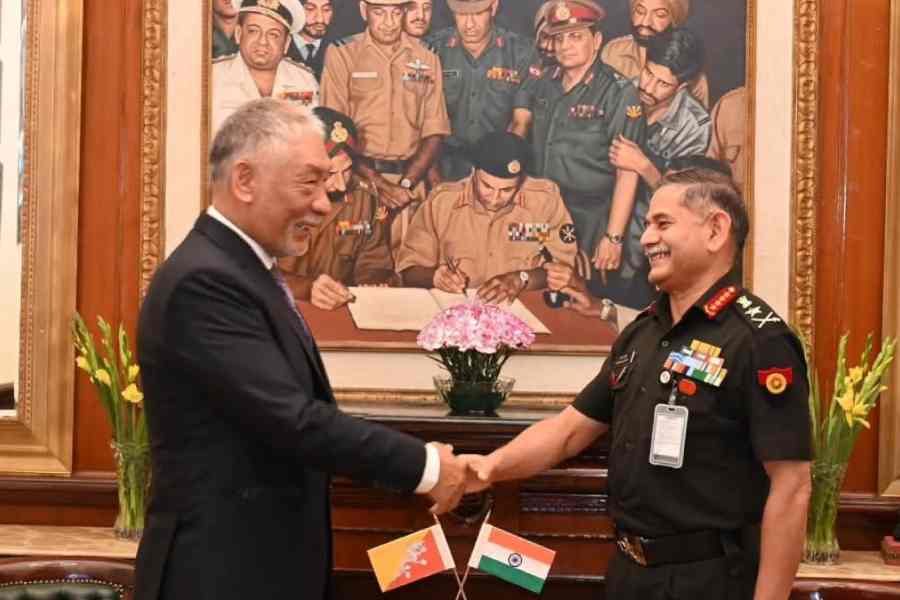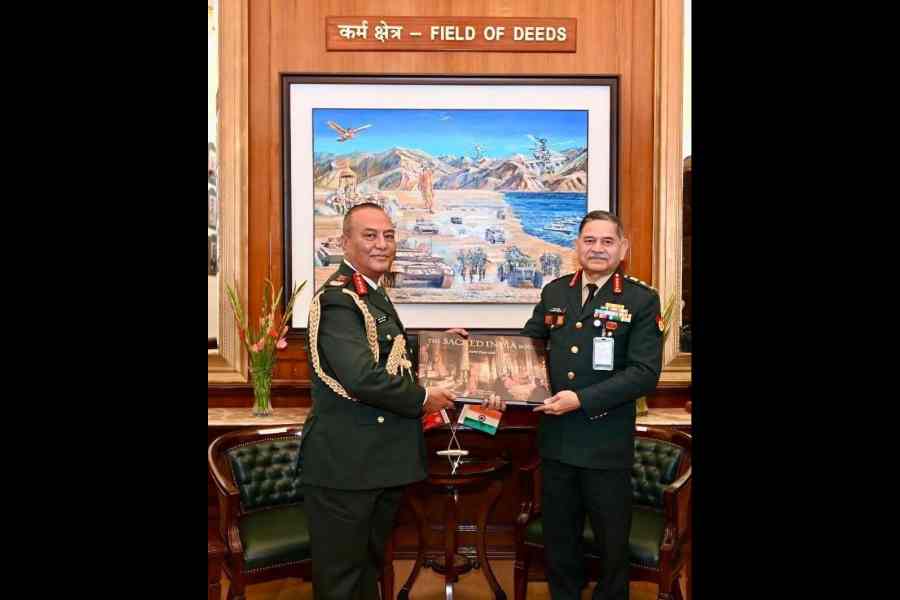For half a century, the most vivid symbol of India’s greatest military victory was a photograph of the Pakistani army signing the Instrument of Surrender in Dhaka on December 16, 1971.
It has now emerged that the picture has been removed from the office of the army chief, where it hung proudly for decades, often forming the background against which visiting generals and other foreign dignitaries were photographed.
Its replacement is a painting — “drawn from the teachings of the Mahabharata”, according to defence sources — that shows tanks and helicopters on the banks of what appears the Pangong Lake in Ladakh, overseen by a charioted warrior, a saffron-clad sage and a bird.
Military veterans have castigated the Narendra Modi government and military brass for replacing the old photograph — a fact that became widely known on Thursday night — calling it a “disgrace”, an assault on military history and an insult to those who fought and fell in the 1971 Bangladesh war.
A former brigadier told this newspaper the reason could only be political — “the regime trying to erase the memory of the 1971 victory because it came under Prime Minister Indira Gandhi”.
Such a motive would be ironic on the part of the Modi government, for Indira’s success in defeating and partitioning Pakistan had made her a darling of the RSS.

A post shared by the Army on social media in November shows the Instrument of Surrender picture as Gen Dwivedi (right) greets a foreign dignitary at his office Sourced by The Telegraph
It’s doubly ironic, for India’s removal of the celebrated photo coincides with the new rulers of Bangladesh virtually disowning the ideals of 1971 and its heroes and questioning New Delhi’s motives in facilitating the Liberation War.
As a third irony, the revelation of the picture swap comes just days before December 16, celebrated as Vijay Divas to mark the Indian armed forces’ finest hour and honour its dead.
If there’s a fourth irony, it’s that the new painting purportedly shows a theatre of conflict that is widely held to symbolise India’s military and political capitulation to China.
“It’s shocking that the military brass did not object to removing the picture and, instead, pandered to political whims,” the ex-brigadier said.
The photograph shows Lt Gen. A.A.K. Niazi of Pakistan signing the Instrument of Surrender before Lt General Jagjit Singh Aurora, commander of the Indian and Bangladesh forces in the eastern theatre. Behind them stand Vice-Admiral Krishnan, Air Marshal Dewan, Lt Gen. Sagat Singh and Maj. Gen. Jacob.
“This photograph reinforces our national pride. But what can we expect from a government that is busy ‘changing’ history?” a former major general told The Telegraph.
A picture the government had released — showing the army chief greeting his visiting Nepal counterpart against the backdrop of the new painting — was the first indication that the old photograph had been got rid of.
In a post on X, Lt gen. (retd) H.S. Panag said: “The photo/ painting symbolising India’s first major military victory in a 1000 years... has been removed by a hierarchy which believes that mythology, religion and distant fragmented feudal past will inspire future victories.”
Replying to him, Vice-Admiral (retd) Jaggi Bedi said: “Times surely changing. Bend like the reed is the new normal.”
Former Air Vice-Marshal Manmohan Bahadur posted on X: “…Dignitaries and military heads of other countries meet the Army chief here and see the symbol of the Greatest Event In India…. Now, this ham-handed effort —at what?”
Maj. Gen. (retd) Yash Mor told this newspaper: “This is sad. The photograph captures the only military victory in our modern history.”
Contacted, the army spokesperson declined comment.
A senior defence ministry official sent a WhatsApp message to this newspaper defending the move, arguing the new semi-mythological painting showcased the Indian military’s technological progress and “timeless commitment to righteousness”.
“….The painting Karam Kshetra — Field of Deeds has been painted by Lt Col Thomas Jacob of 28 MADRAS. This painting represents the Indian Army’s timeless commitment to righteousness, as drawn from the teachings of the Mahabharata,” it said.
“It portrays the Army as a guardian of Dharma…. This inspiration is complemented by the strategic and philosophical wisdom of Chanakya, whose principles guide the Army’s approach to leadership, diplomacy, and warfare.”
Apparently, the painting also “reflects how the modern Indian Army is equipped with cutting-edge systems, seamless coordination across land, air, and sea….”
India’s army may not have had “cutting-edge systems” in 1971 but the way it conducted the 13-day war is the stuff of legend.
As Dhaka (then Dacca) fell, India demanded the Pakistan army surrender in 30 minutes. Niazi had little choice.
The surrender ceremony was held at the Race Course. Niazi surrendered with 93,000 soldiers before the Indian Army and the Mukti Bahini as thousands of gathered Bangladeshis threatened to lynch the Pakistani general. Indian officers formed a cordon around Niazi and whisked him off in an Indian jeep.
When Indira Gandhi announced the victory in Parliament, the House erupted.
Atal Bihari Vajpayee, then an ordinary MP but later to become the first BJP Prime Minister, was reported as extolling Indira as “Durga”. Decades later, he denied it.

